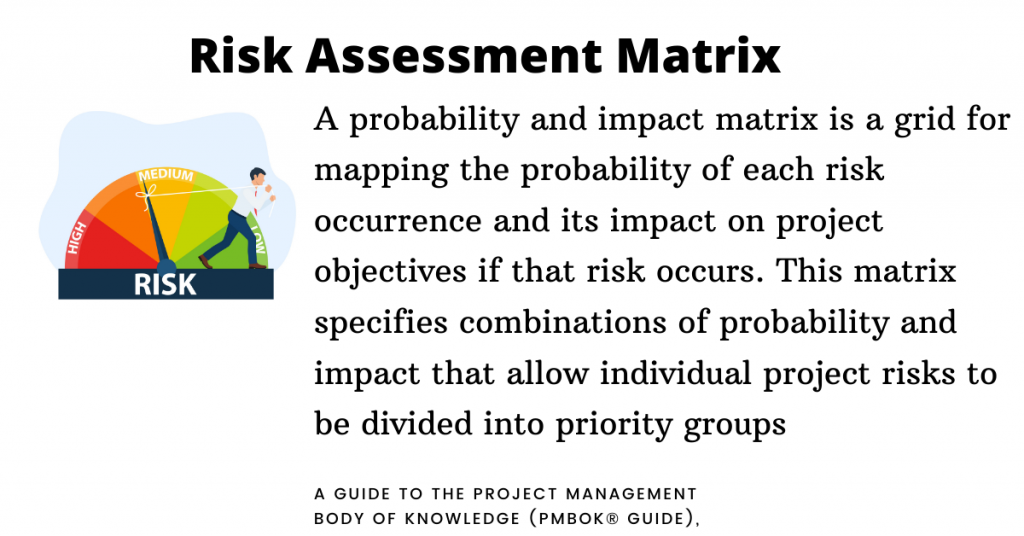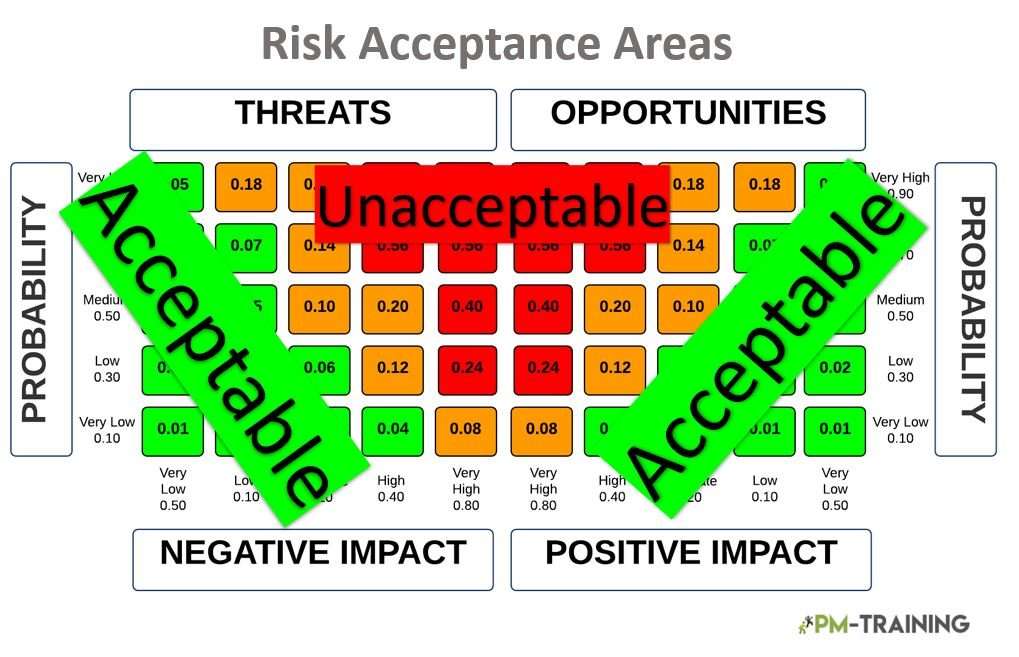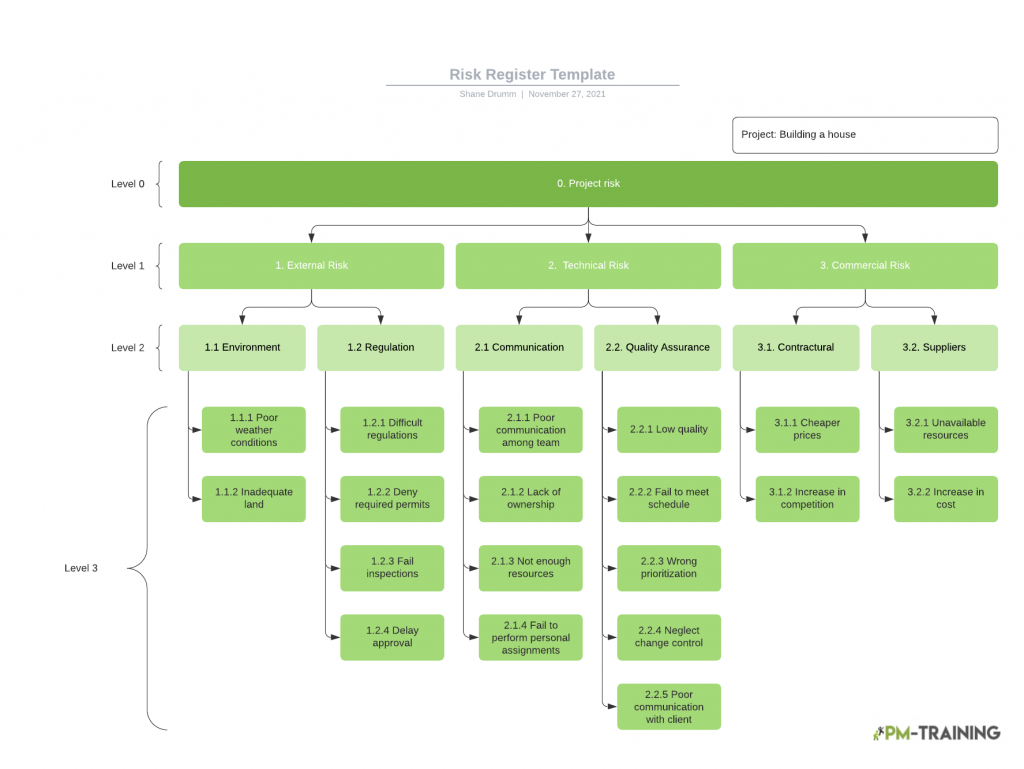Risks that occur in project management are evident as being unexpected factors that present themselves within a project in a way that could affect the project’s outcome. Something that is important to know when it comes to running a project is that it is relatively rare that it can be completed without coming in contact with risks of any size.
With this in mind, it is important to know that the project manager holds the responsibility of ensuring that they are aware of potential risks that can occur in a project as well as having an established method that their team can execute as a means of mitigating the impact of the risk. One way to do this is through building a risk assessment matrix project management system.
A risk matrix, also known as a Probability and Impact Matrix, is a tool that is best utilized to assist project managers to execute a risk evaluation or determine the probability of a potential risk occurring. In A Guide to the Project Management Body of Knowledge a risk matrix would be described as “a grid for mapping the probability of each risk occurrence and its impact on project objectives if that risk occurs. This matrix specifies combinations of probability and impact that allow individual project risks to be divided into priority groups”.

Benefits of Using the Risk Matrix
The benefit of having a risk matrix is that it essentially allows for the risk within a project to be calculated faster so that a project management team can prioritize which problems they would need to take action in addressing. It also allows for members of the team and its stakeholders to have a visual of all of the factors and their ability to affect a project’s outcome. Having a visual understanding of these factors contributes to the confidence that stakeholders will have in going further in execution.
When To Use The Risk Matrix
Using the risk assessment matrix finds itself beneficial for your project management team when it comes to implementing any changes within a project. It is best utilized before a team makes any changes in the process of completing a task or if there is a new task altogether. If there is new information that is presented about a task, this would be an ideal time for you to determine the risks of applying that information. It is also important to develop a matrix when there is a known hazard that has occurred.

How To Create a Risk Assessment Matrix
All assessments that are done to build a matrix should be done by the person that is most competent through their knowledge of the project and their ability to perform the proper analysis necessary to identify each risk. The framework of building the matrix can be done in 3 steps:
The first step that you need to do when creating a risk matrix is to separate all of the risks that could threaten the progress of the project. This includes all internal and external factors. Some examples of these factors would be the number of resources or finances that are available to complete the project.
After all of the risks have been adequately separated, the next step that you and your team will need to do is categorize each one to determine the likelihood of the risk occurring as well as the severity in the event that the risk does occur. It is ideal for you to assign a numerical value to each risk on a scale. Be sure to tailor each risk value as it fits the needs of your particular project.
The final step to creating the matrix is making a determination as to where your team needs to prioritize. Once your team establishes which risks are of higher priority, you can now work through the methods of executing the mitigation efforts of the risks. Having a strategic plan in action allows your team to resolve the risks as well as create a preemptive measure for risks in the future so that they don’t occur again or the severity of their impact is lessened.
Risk Assessment Matrix Template Google Sheets

Construction Risk Assessment Matrix

Risk Assessment Checklist
Every project management team will navigate between a variety of other characteristics alongside the probability and impact of a risk when it comes to determine where to prioritize efforts of mitigation. These other risk parameters include:
Urgency This is the measurement of time that is allotted for a team to effectively respond towards a risk. Shorter time means that the risk parameter is high urgency.
Proximity This is the time frame that is allotted before a risk begins to have impact towards other aspects of a project.
Dormancy This is the time frame that has passed after the occurrence of a risk and before the impact of the risk was discovered.
Manageability This is the level of ease that the owner of the risk is capable of managing the risk. If there is low difficulty in management, the manageability is high.
Controllability This is the level of where the owner of the risk is able to have control of the outcome of the risk. If the outcome can be controlled easily, then the controllability is high.
Detectability This is determined by how easy it is to determine and recognize when risks are occurring or close to occurring. Easily being able to detect the occurrence of risk makes the detectability high.
Connectivity This determines the connection of a risk to other individual risks within a project. If there are risks connected to many others, then the connectivity is high.
Strategic impact The ability to measure how a risk could potentially have a positive or negative effect on the goals of an organization. If the risk significantly effects the goals, then it would have a high strategic impact.
Propinquity The level that the risk is perceived of importance by stakeholders. If the perception is perceived to have high importance, then it would have a high propinquity.
These parameters strengthens the prioritization efforts in a way that assessing probability and impact alone would not have been able to accomplish.
Risk Register
The risk register provides information on threats and opportunities that may impact project execution. The risk register captures details of identified individual project risks. The results of Perform Qualitative Risk Analysis, Plan Risk Responses, Implement Risk Responses, and Monitor Risks are recorded in the risk register as those processes are conducted throughout the project. The risk register may contain limited or extensive risk information depending on project variables such as size and complexity.

Risk Assessment Matrix FAQs
What is risk assessment matrix in project management?
Risk assessment matrix in project management identifies risks while factoring internal and external contributors. It simplifies a presentation for the calculated information so that the team can have an easier method of making decision.
How do you do a risk assessment matrix?
To build a risk assessment matrix, it is necessary to identify risks. Afterwards, you determine the likelihood of occurrence, consequences, and the rating of the risk. Once these things are adequately calculated, you create an action plan then input the necessary data.
What are the 5 principles of risk assessment?
The five principles of risk assessment are risk identification, risk analysis, risk control, risk financing and claims management.
Do I use a risk assessment matrix tool to create risk categories?
A risk assessment matrix tool is a visual tool that reflects the potential risks that are affecting a project or business. It allows for a project team to visibly see the probability and the severity of a risk. Creating categories for risks to be placed into allows for beneficial and effective risk response to be developed. These risk categories allows for project management teams to prioritize areas that are measured to being of high risk exposure, or creating an established protocol for responding to risks in the future as they are determined to being similar to risks that teams were exposed to from a prior project.
What are the 4 types of risk assessment?
The four types of risk assessments are Risk acceptance, Risk transference, Risk avoidance, and Risk reduction.
What is a 5×5 risk matrix?
The risk assessment matrix 5×5 is a matrix that contains 5 levels each of probability that a risk would occur and the severity of the risk’s occurrence within a project.
What are the 5 levels of risk?
The five levels of risk are:
Improbable – most unlikely for the risk to occur
Remote – less unlikely for the risk to occur but still possible.
Occasional – likely for the risk to occur sometimes
Probable – A more likely risk occurrence that can occur at any time
Frequent – an expected risk that occurs often.
